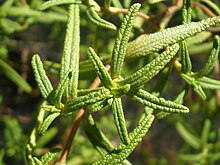Cistus monspeliensis
| Cistus monspeliensis | |
|---|---|

| |
| Scientific classification | |
| Kingdom: | Plantae |
| Clade: | Tracheophytes |
| Clade: | Angiosperms |
| Clade: | Eudicots |
| Clade: | Rosids |
| Order: | Malvales |
| Family: | Cistaceae |
| Genus: | Cistus |
| Species: | C. monspeliensis
|
| Binomial name | |
| Cistus monspeliensis | |
Cistus monspeliensis is a species of rockrose known by the common name Montpellier cistus or narrow-leaved cistus. It is native to southern Europe and northern Africa, in the Mediterranean forests, woodlands, and scrub ecosystems of matorral—maquis shrublands.
Description
[edit]
Cistus monspeliensis is a shrub with narrow evergreen leaves and a hairy, glandular, sticky surface. The leaves are linear to lance-shaped, green, with a rugose, wrinkled upper surface, up to 5 centimeters long. In cultivation, C. monspeliensis attains a height of around one meter and a width of 1.5 metres.[2]
The plant's inflorescence is generally a panicle of 2 to 8 flowers, each with five sepals and five white petals.[3]
Distribution
[edit]It is mainly distributed throughout the western Mediterranean Basin (Portugal, including Madeira; Spain, including the Canary Islands and Balearic Islands; Morocco; southern France, including Corsica; Italy, including Sardinia and Sicily; Malta; Algeria; Tunisia) but it is also present in Croatia; Serbia; Albania; Montenegro; Greece and Cyprus.[1]
The plant has been reported elsewhere as an introduced species, and in California as an invasive species.[3]
Phylogeny
[edit]Cistus monspeliensis belongs to the white and whitish pink flowered clade of Cistus species.
| Species-level cladogram of Cistus species. | ||||||||||||||
| ||||||||||||||
| Species-level cladogram of Cistus species, based on plastid and nuclear DNA sequences.[4][5][6][7] |
References
[edit]- ^ a b Rankou, H.; M'Sou, S.; Ait Babahmad, R.A.; Diarra, A. (2020). "Cistus monspeliensis". IUCN Red List of Threatened Species. 2020: e.T73094084A139593829. doi:10.2305/IUCN.UK.2020-1.RLTS.T73094084A139593829.en. Retrieved 19 November 2021.
- ^ "Cistus monspeliensis (Montpelier rockrose)". Shoot gardening. Retrieved 25 February 2021.
- ^ a b http://ucjeps.berkeley.edu/cgi-bin/get_JM_treatment.pl?3215,3216,3219 Jepson
- ^ Guzmán, B. & Vargas, P. (2005). "Systematics, character evolution, and biogeography of Cistus L. (Cistaceae) based on ITS, trnL-trnF, and matK sequences". Molecular Phylogenetics and Evolution. 37 (3): 644–660. Bibcode:2005MolPE..37..644G. doi:10.1016/j.ympev.2005.04.026. PMID 16055353.
- ^ Guzmán, B. & Vargas, P. (2009). "Historical biogeography and character evolution of Cistaceae (Malvales) based on analysis of plastid rbcL and trnL-trnF sequences". Organisms Diversity & Evolution. 9 (2): 83–99. Bibcode:2009ODivE...9...83G. doi:10.1016/j.ode.2009.01.001.
- ^ Guzman, B.; Lledo, M.D. & Vargas, P. (2009). "Adaptive Radiation in Mediterranean Cistus (Cistaceae)". PLOS ONE. 4 (7): e6362. Bibcode:2009PLoSO...4.6362G. doi:10.1371/journal.pone.0006362. PMC 2719431. PMID 19668338.
- ^ Civeyrel, Laure; Leclercq, Julie; Demoly, Jean-Pierre; Agnan, Yannick; Quèbre, Nicolas; Pélissier, Céline & Otto, Thierry (2011). "Molecular systematics, character evolution, and pollen morphology of Cistus and Halimium (Cistaceae)". Plant Systematics and Evolution. 295 (1–4): 23–54. Bibcode:2011PSyEv.295...23C. doi:10.1007/s00606-011-0458-7. S2CID 21995828.
External links
[edit]

